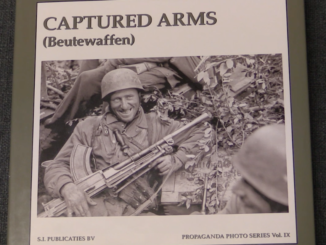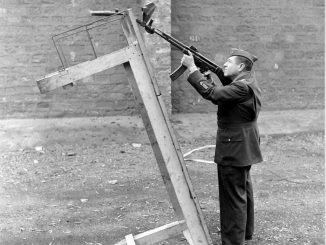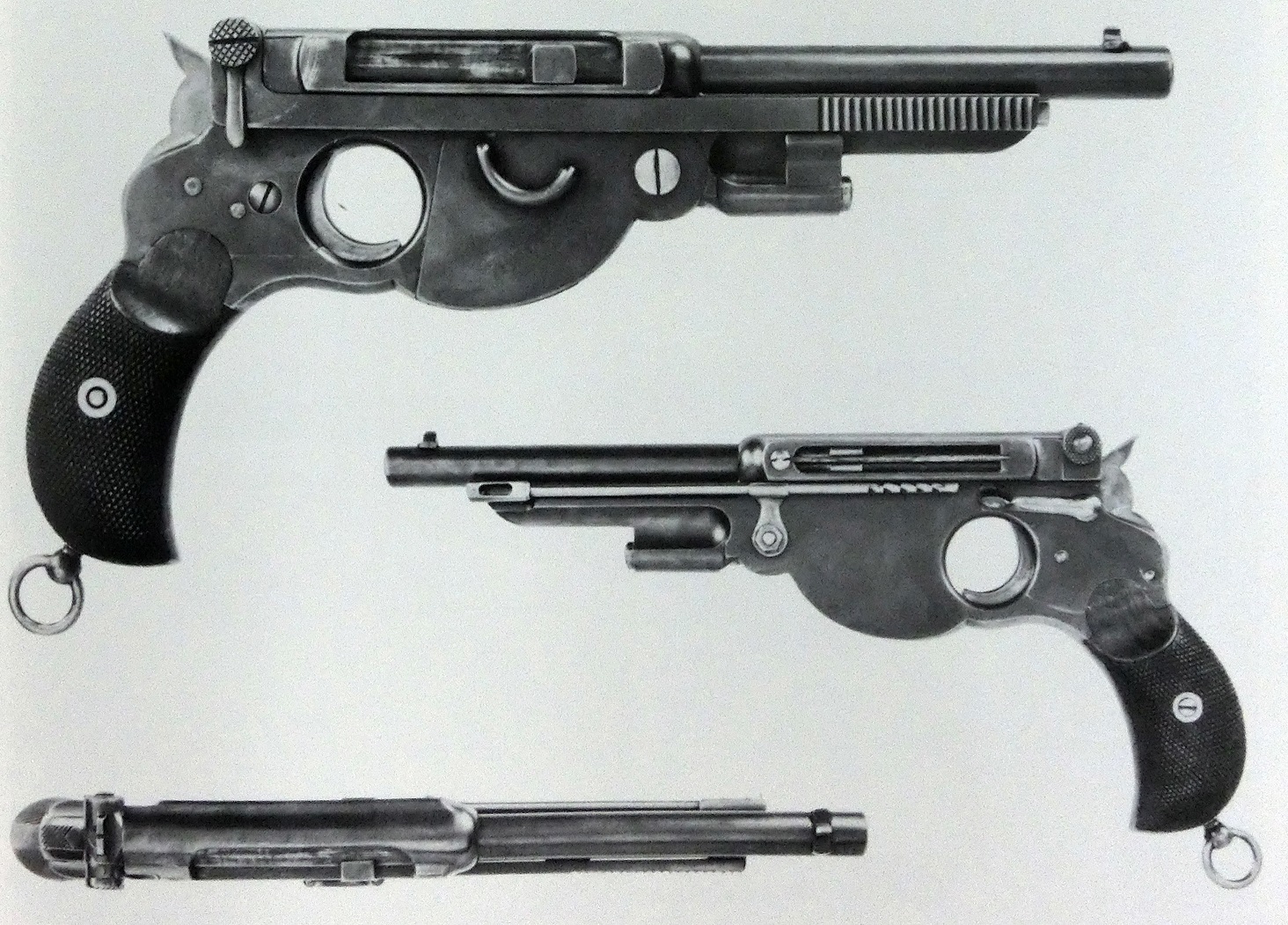When Mauser began development of the HSc pistol, it was intended to be a pair of guns – a simple blowback gun in .32 or .380 caliber for civilian and police use and a larger locked-breech type in 9x19mm for military use. Mauser had tried this before with their 1910 pocket pistol, but in that effort they tried to make both sizes blowback, which did not work well. This time, the designer – Alex Seidel; later a founder of H&K – looked at what technology Mauser owned, and chose Josef Nickl’s rotating barrel patent to use in the 9×19 version of the HSc.
This pistol is number V1001, the very first prototype HSc, and it’s one of the rotating barrel locked breech guns. Ultimately this gun suffered the same fate as the Mauser 1909; it was not accepted by the military, and saw no commercial production. The German military would decide that it required an exposed barrel, which the HSc did not have. Mauser would develop the HSv for military trials, but it would be defeated by the Walther HP, which was adopted as the P38.




Fantastic Ian. What time machine do you use to get the very first guns you present. How about the very first gun ever made? Excellent presentation.
Ian – any thoughts as to why the German military required an exposed barrel? The additional cooling would seem to be unwarranted, and the possibility of burning one’s hands would be a negative. (Mind that I’ve never burned my hands on my P38 nor my Imperial Luger).
Perhaps there was a preference for guns that handled more like older revolvers. Either that or someone wanted fewer things that could go wrong in trench mud, so a more compact receiver unit was specified (less interface that needs to be tightly sealed). Did I mess up?
“(…)required an exposed barrel(…)”
Soviet Union in late 1930s required such feature, so automatic pistol would fit into firing ports of tanks, originally designed for Nagant 1895. Was this requirement considered MUST have in Germany? Apparently in early 1930s developed “PP but firing 9×19 Parabellum cartridge” including full-length slide, see photos:
https://www.rockislandauction.com/detail/72/2625/walther-model-mp-semiautomatic-prototype-pistol
as potential service automatic pistol. It was not developed further, but it is not surprising as it was blow-back. Did German forces specified exposed barrel as must have some time later or just simply Walther design win?
The tank firing port design was a factor, but that port was more than large enough for even the slide of a Browning type pistol because it was made to fit a submachine gun, such as first the MP28 and then the MP38/40. So it had to accommodate such things as the MP28’s barrel jacket and the rifle-type front sight assemblies of both the 28 and the 38/40.
That folding “bar” under the Erma’s barrel wasn’t primarily for unscrewing the barrel during detail stripping, it was to be hooked on the outside of the tank turret through the firing port, like the “hook” under the muzzle of a hackenbusche.
In the MP’s case, it was to prevent recoil from forcing the muzzle back far enough to have 9mm bullets bouncing off the inside of the turret and ricocheting about the fighting compartment.
So the firing port had to be big enough to let it through, as well.
I think ultimately the Wehrmacht just wanted a pistol that handled as much like the P08 as possible. A “muzzle-light” weapon that had the same general balance as a revolver.
By 1942 or so, when they needed any handguns they could get, you may notice that Vis 1935s built at Radom in Poland and Pistole 640(b)aka P-35 High Powers built at Liege’ in Belgium were issued to pretty much anybody who needed a handgun. I understand that the High Power was favored by the Waffen SS due to its reliability and greater magazine capacity.
Nobody seemed to care much about their having full-length slides and not handling “just like a revolver” by that point.
cheers
eon
Pretty much the similarity in handling to the P.08 and bad experiences in the Great War dictated the requirements for the new service pistol for the Wehrmacht. The bulged barrels preventing the slides from moving in the various ad hoc bought pistols that the old army issued. even with a bulged barrel from firing with a mud plug in the barrel a C96 or P.08 will still cycle as normal.
I would really like to know how this prototype HSc pistol shoots compared to its competitors in the trials.
Very informative… Thanks lan… lt seems prototype HSv models lan formeriy shared had better improvements over standart HSc’s. This model seems a simple transition from Nickl’s design to Seidel’s with a better design and location of manual safety lever. lMHO…
A solid design with little chance in Germany. In all truth, Czechs had somewhat thorny beginnings with it too. Just a minor correction – the Nickel’s design license went to Praga first, later production moved to Brno.
Keep on plugging Ian!
That is one good looking pistol. From the way it handles, I would prefer it to a Walther P38. I think the German army probably did have an idea of firing pistols through pistol ports in tanks, though whether that actually happened much is another matter. I wish it could have gone into civilian or police use after the war. You don’t see much blued steel and walnut these days.
Strongly agree. I think that gun could sell now.
The Grand Power pistols from Slovakia use a rotating barrel. But the Mauser HSc is purdier certainly.
And there is the Glock 46 of course.
Gorgeous!
Ian is the best.
It is interesting that Makarov walked on the same rake with safe.
After a certain number of shots, due to the weakening of the fixation of the safe lever in the socket, spontaneous switching on occurs.
Apparently, Walther also faced the same problem at the time.
I have the solution! Just add a Beretta Model 1934 frame-mounted safety to the mix. Then everything will be fine!
…why are you guys looking at me that way?
I have always wondered why like 99% of slide mounted safeties with this way and not the other. Makes sense that recoil moves them otherwise.
Friends,
Re: exposed barrel.
I have read, without a citation, that an exposed barrel when plugged with dirt, would bulge without slide damage.
One could rebarrel rather than replace the slide and barrel.
I would be interested if anyone has a citation from the German literature for this.
Q
Friends,
By luck I came across this Youtube™ discussion of the complete destruction of a Glock™ pistol.
The shooter had no powder in one cartridge and fired his next round into the bullet.
See: https://www.youtube.com/watch?v=ws_DKkyHrvc
I suspect a squib round would have destroyed both the P08 and the P38, but a block at the barrel end would not have taken the slide with it.
Q
It depends on where the first bullet gets stuck. If closer to the face, for both pistols it will most likely be a slight bloat. Something like that.
https://luger.gunboards.com/showthread.php?7749-Not-a-rare-Experimental-Officers-Model
If right after the chamber, for the P38 is okay. Although, this does not add health.
And in Luger, the barrel and the upper can burst.
And in the video by reference, a makeshift barrel was made of boiler iron or nails.
The case is practically intact. This means that the pressure was not very high.
A barrel burst in half. Shitty steel.
One thing we should consider is that the Glock 46, specifically designed by Brigadier Dechant for loads on the “hot” side, also uses a rotating barrel locked breech system.
Today’s tilting barrel designs, using the ejection opening in the slide, are often associated with John M. Browning. I think he would turn in his grave if he knew. Browning NEVER used the ejection opening as a locking surface.
In my view a rotating barrel, as in the Mauser HSc shown here, can offer a lot of locking surface and is a very smart approach for high powered cartridges.
Nice gun.